Student Loans Surpasses Auto Loans and Credit Card Debt
The holidays are over. 2016 has begun. The number-one New Year’s resolution (again) is losing weight, not far behind at number-two is getting out of debt. There’s bad debt, and better debt, but there’s no such thing as good debt. Last year’s holiday capped off a dramatic increase in consumer discretionary spending. But it’s not discretionary spending – it’s consumer borrowing.
Americans have access to significant lines of credit with credits cards, home equity or payday loans. But an emerging trend finds consumers borrowing from their 401(k)s, leveraging their portfolios by creating margin accounts and/or taking policy loans from their cash value life insurance. Millennial graduates starting out in life are behind the eight ball from the get go.
It seems the last decade of the holiday season, we’re singing “tech the halls” over the latest and greatest upgrades, updates and upsells in technology. The new 4K flat screens are out and it can cause you to have an inferiority complex if you don’t buy it, especially when it seems everyone else has it. Can you really tell the difference between 4K and 1080p? Or are you just trying to keep up with your friends? And sometimes it’s not even you friends. Actor Walter Slezak is often quoted, “Spending money you don’t have, for things you don’t need, to impress people you don’t like.”
Most credit card debt purchases buy depreciating assets. The price spread between new and used is so significant that if you spend the time to hunt down deals, its usually time well spent. Consumer credit card debt is estimated somewhere around $700 million. Buying a new car that depreciates the moment you drive it off the lot seems absurd. Even a car, one year older with 15,000 miles on it, can feel and look like new and save you thousands of dollars. Auto loans exceed $1 trillion with a resale value of less than half that. And just attempting to match appliances by color is bad enough, but matching it by brand is just crazy. Bad debt is expensive and the purchase item never adds to your net worth.
Tom Hegna, best selling author and economist, says that there is “bad debt and better debt.” He never said “good debt.” Watch the video interview with Tom at
In the past, good debt was buying a home with a mortgage or funding education. But after going through the housing crisis, home appreciation isn’t a sure thing anymore. Americans hold mortgages at $8 trillion. Are all those homes worth more? And a good education is only as good as a good paying job. It’s estimated college debt is more than one trillion dollars, with no guarantee of enough high-paying jobs to pay it off. So mortgages and college may be better debt, but not good debt. Bottom line: if you continue to borrow from your future, you’ll have no future when you arrive at retirement.
Nationally syndicated financial columnist Steve Savant interviews Tom Hegna, popular platform speaker, retirement expert and best selling author. The show features the Mid Year economic Update for 2016. Tom has two retirement books entitled Don’t Worry Retire Happy and Paychecks and Playchecks. Tom has also hosted the PBS Special, Don’t Worry Retire Happy.



